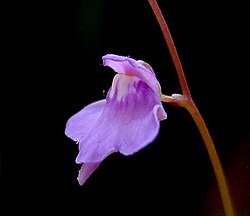Bladderwort
Bladderworts plant are Utricularia, a genus of carnivorous plants. There are about 230 species.[1][2] They occur in fresh water and wet soil as terrestrial or aquatic species. They live in every continent except Antarctica. Bladderworts are cultivated for their flowers, which are rather like those of snapdragons and orchids.
| Bladderwort | |
|---|---|

| |
| Utricularia vulgaris illustration from Jakob Sturm's "Deutschlands Flora in Abbildungen", Stuttgart (1796) | |
| Scientific classification | |
| Unrecognized taxon (fix): | Utricularia |
| Subgenera | |
| Diversity | |
| 233 species | |

| |
| Bladderwort distribution | |
All Utricularia are carnivorous and capture small organisms by means of bladder-like traps. Terrestrial species tend to have tiny traps that feed on minute prey such as protozoa and rotifers swimming in water-saturated soil.
The traps range in size from 0.2 mm to 1.2 cm.[3] Aquatic species, such as U. vulgaris (common bladderwort), have bladders that are usually larger and can feed on water fleas (Daphnia), nematodes, even tiny fish, mosquito larvae and young tadpoles.
Despite their small size, the traps are extremely sophisticated. In aquatic species, prey brush against trigger hairs connected to the trapdoor. The bladder, when "set", is under negative pressure: when the trapdoor is triggered, the prey, with the water around it, is sucked into the bladder. Once the bladder is full of water, the door closes again. The whole process takes only ten to fifteen thousandths of a second.[4][5]
Bladderworts are unusual and highly specialized plants.[6] The bladder traps are recognized as one of the most sophisticated structures in the plant kingdom.[3]
Bladderwort Media
Utricularia amethystina flower
Utricularia aurea growing in a rice paddy in Thailand.
Traps of Utricularia aurea
Trap of Utricularia hamiltonii
Bladderwort traps: long, usually branching (but here simplified), antennae guide Daphnia to the trapdoors of an aquatic bladderwort.
The flower stem of the aquatic Utricularia inflata is held aloft by a rosette of floats.
References
- ↑ Slack, Adrian 2000. Carnivorous plants, revised edition. MIT Press: Cambridge, Massachusetts. ISBN 978-0-262-69089-8
- ↑ Salmon, Bruce. 2001. Carnivorous plants of New Zealand. Ecosphere Publications. ISBN 978-0-473-08032-7
- ↑ 3.0 3.1 Taylor, Peter. (1989). The genus Utricularia - a taxonomic monograph. Kew Bulletin Additional Series XIV: London. ISBN 978-0-947643-72-0
- ↑ D'Amato, Peter. 1998. The savage garden: cultivating carnivorous plants. Ten Speed Press: Berkeley, California. ISBN 978-0-89815-915-8
- ↑ Lloyd F.E. 1942. The carnivorous plants. The Ronald Press Company: New York. ISBN 978-1-4437-2891-1
- ↑ Rutishauser, Rolf; Isler B. "Developmental genetics and morphological evolution of flowering plants, especially bladderworts (Utricularia): fuzzy arberian morphology complements classical morphology". Annals of Botany. 88 (1173): 1202.






